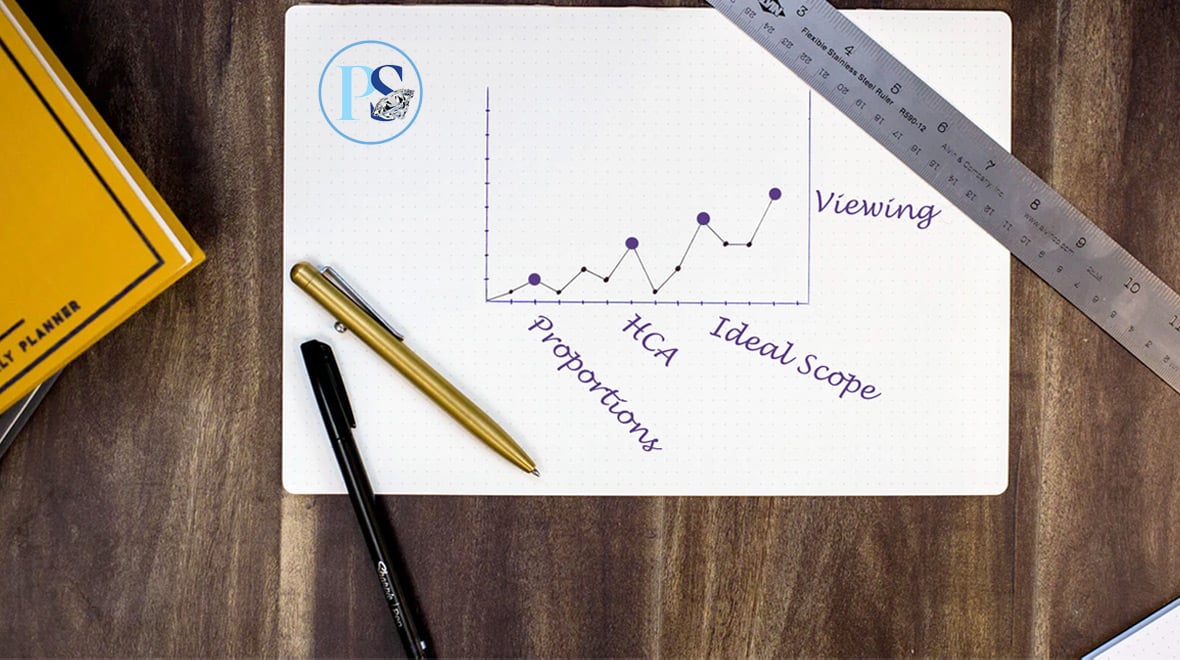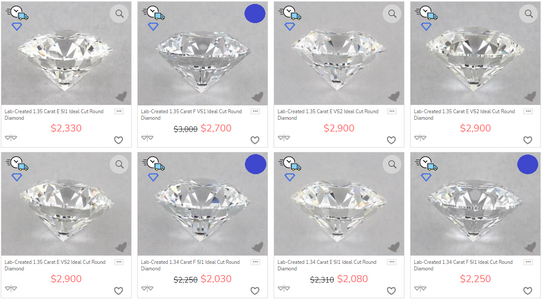Hello,
Curious how this stone looks? Thanks for any input!
 www.withclarity.com
www.withclarity.com
Curious how this stone looks? Thanks for any input!
Not liking the proportions or the looks of it...it may have some moderate light leakage.
Have a look at these possible alternatives;
1.10 Carat Round Diamond Ideal Cut D Color VS2 Clarity
www.withclarity.com
1.10 Carat Round Diamond Ideal Cut E Color VS2 Clarity
www.withclarity.com
Are you open to other sellers, or is WC your requirement?
Not liking the proportions or the looks of it...it may have some moderate light leakage.
Have a look at these possible alternatives;
1.10 Carat Round Diamond Ideal Cut D Color VS2 Clarity
www.withclarity.com
1.10 Carat Round Diamond Ideal Cut E Color VS2 Clarity
www.withclarity.com
Are you open to other sellers, or is WC your requirement?
Frustrating, right? Ideal cut should mean… ideal!
But, sadly this is not always the case. In many labs (e.g., GIA, EGL), the “Ideal” or “Excellent“ category for cuts are simply too wide a range (e.g., if we used an example from academic grading, the Ideal / Excellent category for cut might include A+, A, A-, B+, B, and B-). I don’t know about you, but I don’t want a B-.
The good news is that there are pretty standard proportions for the best cut modern round brilliant, so they CAN be evaluated online, even if the cut grade on the grading report isn’t going to tell us enough.
One note, the lab AGS does tend to have reliable cut grades. AGS0 for modern round brilliants basically means ideal cut (basically an A). There are some diamond vendors that make special branded superideal cuts (and charge $$) that might be at the very top end of AGS0, but that is about differentiating between A and A+.
IGI (that grades a lot of Lab Grown Diamonds) is newer to cut grading in this space, and so I don’t think there is yet an agreed-upon view that their cut grades are reliable.
Things to do:
+ Use the HCA (holloway cut advisor) as a rejection tool. Input the stone’s proportions (depth, table, angles) and look for scores less than 2. The HCA is a rejection tool - so anything greater than 2 should be discarded (in general). 0.5 is not better than 1 is not better than 2.0. Stones scoring under 2 are worthy of consideration.
+ Learn from some of the specification “cheat sheets” here on PS. This is an oldie but goodie (https://www.pricescope.com/community/threads/preferred-specs-cheat-sheet-for-rounds.88548/) for example.
+ Look for vendors who are willing to show you images using IdealScopes or ASETS (these are tools to help evaluate cut). This can be tricker in the lab-grown world as they might be less available. Many experienced PS members can help you evaluate these images in the forums.
+ Work with trusted vendors who know great cuts. For example, I’ve recently purchased LGDs from Jonathan at DistinctiveGems because he is able to evaluate the cut performance of stones using the AGS evaluation software, which he leases. He’s a recommended PriceScope vendor, and I’ve read enough over the years to rely on his advice. This is just an example that I can speak to personally - there are MANY other trusted vendors who could also give you very good advice about the cut quality of LGDs.
My response might be a bit more than you bargained for, but there is no reason not to buy a stone that is extremely well cut. Cut is the thing that is going to have the most visual impact!
Happy hunting!
Frustrating, right? Ideal cut should mean… ideal!
But, sadly this is not always the case. In many labs (e.g., GIA, EGL), the “Ideal” or “Excellent“ category for cuts are simply too wide a range (e.g., if we used an example from academic grading, the Ideal / Excellent category for cut might include A+, A, A-, B+, B, and B-). I don’t know about you, but I don’t want a B-.
The good news is that there are pretty standard proportions for the best cut modern round brilliant, so they CAN be evaluated online, even if the cut grade on the grading report isn’t going to tell us enough.
One note, the lab AGS does tend to have reliable cut grades. AGS0 for modern round brilliants basically means ideal cut (basically an A). There are some diamond vendors that make special branded superideal cuts (and charge $$) that might be at the very top end of AGS0, but that is about differentiating between A and A+.
IGI (that grades a lot of Lab Grown Diamonds) is newer to cut grading in this space, and so I don’t think there is yet an agreed-upon view that their cut grades are reliable.
Things to do:
+ Use the HCA (holloway cut advisor) as a rejection tool. Input the stone’s proportions (depth, table, angles) and look for scores less than 2. The HCA is a rejection tool - so anything greater than 2 should be discarded (in general). 0.5 is not better than 1 is not better than 2.0. Stones scoring under 2 are worthy of consideration.
+ Learn from some of the specification “cheat sheets” here on PS. This is an oldie but goodie (https://www.pricescope.com/community/threads/preferred-specs-cheat-sheet-for-rounds.88548/) for example.
+ Look for vendors who are willing to show you images using IdealScopes or ASETS (these are tools to help evaluate cut). This can be tricker in the lab-grown world as they might be less available. Many experienced PS members can help you evaluate these images in the forums.
+ Work with trusted vendors who know great cuts. For example, I’ve recently purchased LGDs from Jonathan at DistinctiveGems because he is able to evaluate the cut performance of stones using the AGS evaluation software, which he leases. He’s a recommended PriceScope vendor, and I’ve read enough over the years to rely on his advice. This is just an example that I can speak to personally - there are MANY other trusted vendors who could also give you very good advice about the cut quality of LGDs.
My response might be a bit more than you bargained for, but there is no reason not to buy a stone that is extremely well cut. Cut is the thing that is going to have the most visual impact!
Happy hunting!


Another option: Lightbox.
They sell their LGDs as loose diamonds!
1.0ct: $800
1.5ct: $1200
1.75ct: $1400
New 2.0ct: $1600
1.0ct Finest: $1500
Frustrating, right? Ideal cut should mean… ideal!
But, sadly this is not always the case. In many labs (e.g., GIA, EGL), the “Ideal” or “Excellent“ category for cuts are simply too wide a range (e.g., if we used an example from academic grading, the Ideal / Excellent category for cut might include A+, A, A-, B+, B, and B-). I don’t know about you, but I don’t want a B-.
The good news is that there are pretty standard proportions for the best cut modern round brilliant, so they CAN be evaluated online, even if the cut grade on the grading report isn’t going to tell us enough.
One note, the lab AGS does tend to have reliable cut grades. AGS0 for modern round brilliants basically means ideal cut (basically an A). There are some diamond vendors that make special branded superideal cuts (and charge $$) that might be at the very top end of AGS0, but that is about differentiating between A and A+.
IGI (that grades a lot of Lab Grown Diamonds) is newer to cut grading in this space, and so I don’t think there is yet an agreed-upon view that their cut grades are reliable.
Things to do:
+ Use the HCA (holloway cut advisor) as a rejection tool. Input the stone’s proportions (depth, table, angles) and look for scores less than 2. The HCA is a rejection tool - so anything greater than 2 should be discarded (in general). 0.5 is not better than 1 is not better than 2.0. Stones scoring under 2 are worthy of consideration.
+ Learn from some of the specification “cheat sheets” here on PS. This is an oldie but goodie (https://www.pricescope.com/community/threads/preferred-specs-cheat-sheet-for-rounds.88548/) for example.
+ Look for vendors who are willing to show you images using IdealScopes or ASETS (these are tools to help evaluate cut). This can be tricker in the lab-grown world as they might be less available. Many experienced PS members can help you evaluate these images in the forums.
+ Work with trusted vendors who know great cuts. For example, I’ve recently purchased LGDs from Jonathan at DistinctiveGems because he is able to evaluate the cut performance of stones using the AGS evaluation software, which he leases. He’s a recommended PriceScope vendor, and I’ve read enough over the years to rely on his advice. This is just an example that I can speak to personally - there are MANY other trusted vendors who could also give you very good advice about the cut quality of LGDs.
My response might be a bit more than you bargained for, but there is no reason not to buy a stone that is extremely well cut. Cut is the thing that is going to have the most visual impact!
Happy hunting!
Not liking the proportions or the looks of it...it may have some moderate light leakage.
Have a look at these possible alternatives;
1.10 Carat Round Diamond Ideal Cut D Color VS2 Clarity
www.withclarity.com
1.10 Carat Round Diamond Ideal Cut E Color VS2 Clarity
www.withclarity.com
Are you open to other sellers, or is WC your requirement?
What do you think of these?
1.12 Carat Round Diamond Ideal Cut E Color VS1 Clarity
www.withclarity.com
1.09 Carat Round Diamond Ideal Cut F Color VS1 Clarity
www.withclarity.com
I think the crown angle is too steep for the 40.9° pavilion angle of the 1.12ct.
The CA is a bit shallow for my liking paired with the 40.6° PA for the 1.09ct, but it appears to be a nice and crisp looking diamond...but I think it may be an undisclosed blue nuance (Type IIb). You'll need to be 100% OK with the light blue/turquoise appearance in certain lighting conditions.
I think the crown angle is too steep for the 40.9° pavilion angle of the 1.12ct.
The CA is a bit shallow for my liking paired with the 40.6° PA for the 1.09ct, but it appears to be a nice and crisp looking diamond...but I think it may be an undisclosed blue nuance (Type IIb). You'll need to be 100% OK with the light blue/turquoise appearance in certain lighting conditions.
Why is this one less? I like this one you linked above. Here is my original choice but is a little too small. I’m just curious what makes it so. I like them both.
1.10 Carat Round Diamond Ideal Cut E Color VS2 Clarity
www.withclarity.com
1.02 Carat Round Diamond Ideal Cut E Color VS1 Clarity
www.withclarity.com
Probably the VS1 versus VS2 clarity grades.
I think the crown angle is too steep for the 40.9° pavilion angle of the 1.12ct.
The CA is a bit shallow for my liking paired with the 40.6° PA for the 1.09ct, but it appears to be a nice and crisp looking diamond...but I think it may be an undisclosed blue nuance (Type IIb). You'll need to be 100% OK with the light blue/turquoise appearance in certain lighting conditions.
Can you help me understand how to discern if there is an undisclosed blue nuance? Is there something specific I can look for? I think I’ll end up with either the E you linked to me or my original 1.02 carat. I searched this site but couldn’t find anything other than folks asking if they’re stones had blue nuance. Still learning the site though!


Sure thing! It's much easier to spot from the side view, where the color can be discerned much easier (the diamonds that I notated with blue dots are blue nuance)...you can see that the blue nuance diamonds appear like ice cubes out of old cartoons with a bit of steely-gray or gray-blue look. With other types of photography/rotational views, you'll be able to actually see the light blue coloring along the crown out near the girdle.
Here's an E VVS2 with undisclosed blue nuance.
Lab Diamonds | Lab Created, Grown Diamonds
At Friendly Diamonds, we have a wide range of lab grown diamonds. You can choose lab diamond by cut, color, clarity, carat and shapefriendlydiamonds.com

Ok. Thanks! So HPHT are the ones that this happens to, right? If the IGI report lists the diamond as IIa is it safe to assume no blue? I can’t seem to trust my own eyeballs
Not liking the proportions or the looks of it...it may have some moderate light leakage.
Have a look at these possible alternatives;
1.10 Carat Round Diamond Ideal Cut D Color VS2 Clarity
www.withclarity.com
1.10 Carat Round Diamond Ideal Cut E Color VS2 Clarity
www.withclarity.com
Are you open to other sellers, or is WC your requirement?
Just wanted to circle back and let you know I went with the 1.10 you linked above! Thanks for your response on my posts
Sure thing! It's much easier to spot from the side view, where the color can be discerned much easier (the diamonds that I notated with blue dots are blue nuance)...you can see that the blue nuance diamonds appear like ice cubes out of old cartoons with a bit of steely-gray or gray-blue look. With other types of photography/rotational views, you'll be able to actually see the light blue coloring along the crown out near the girdle.
